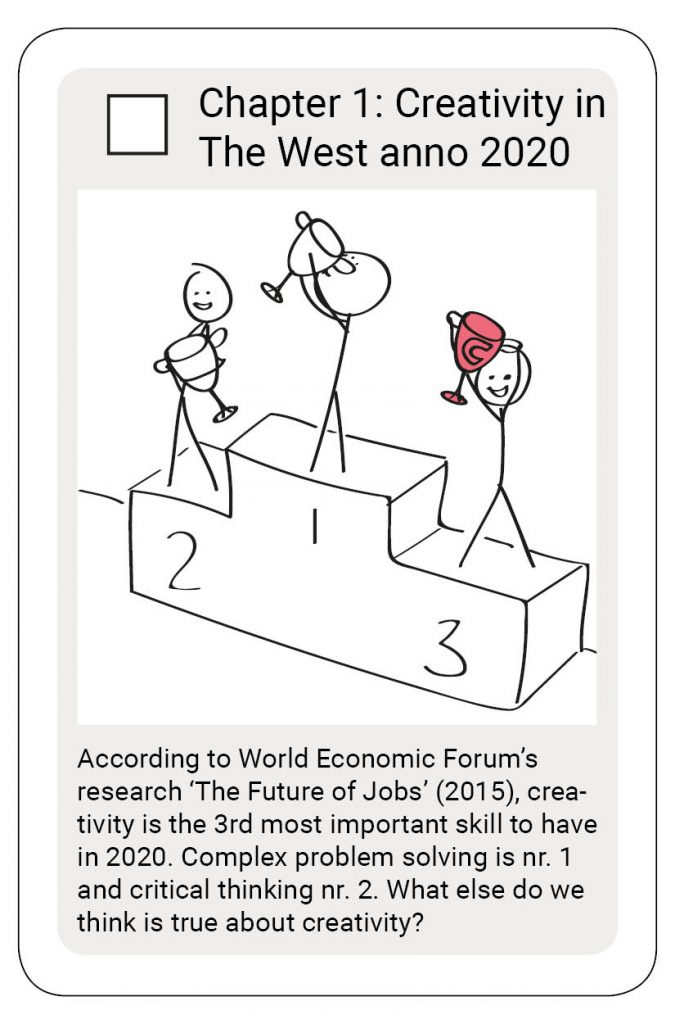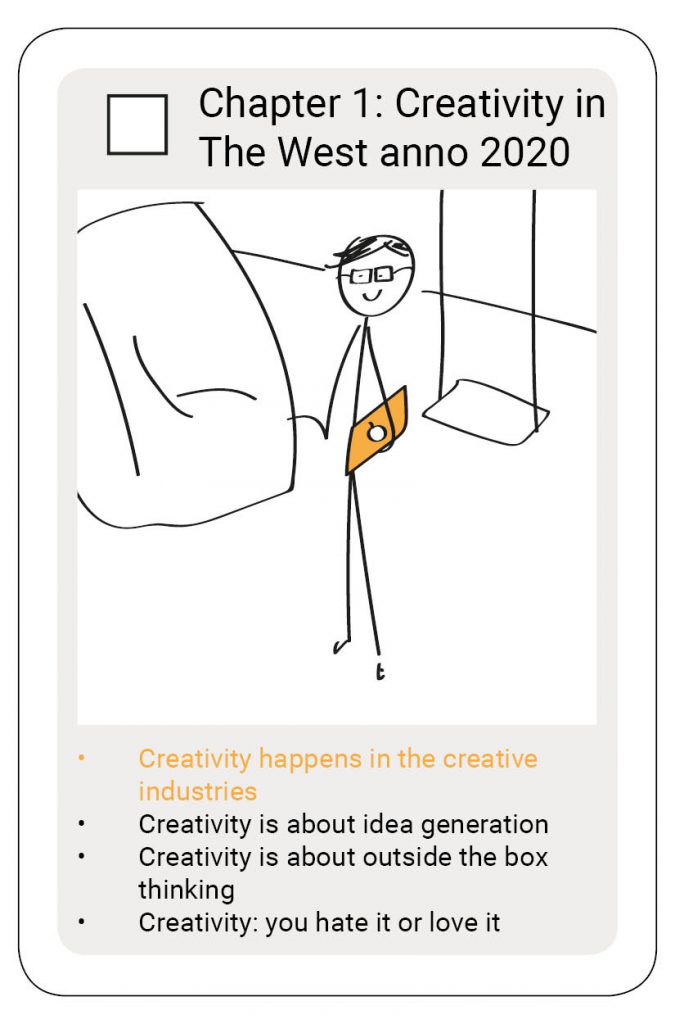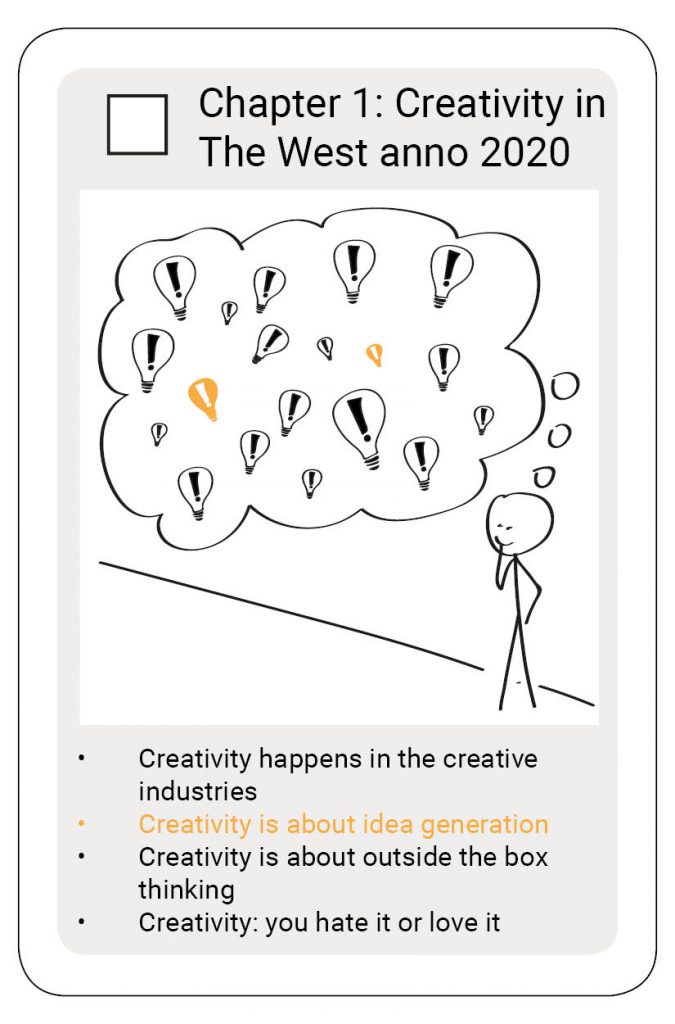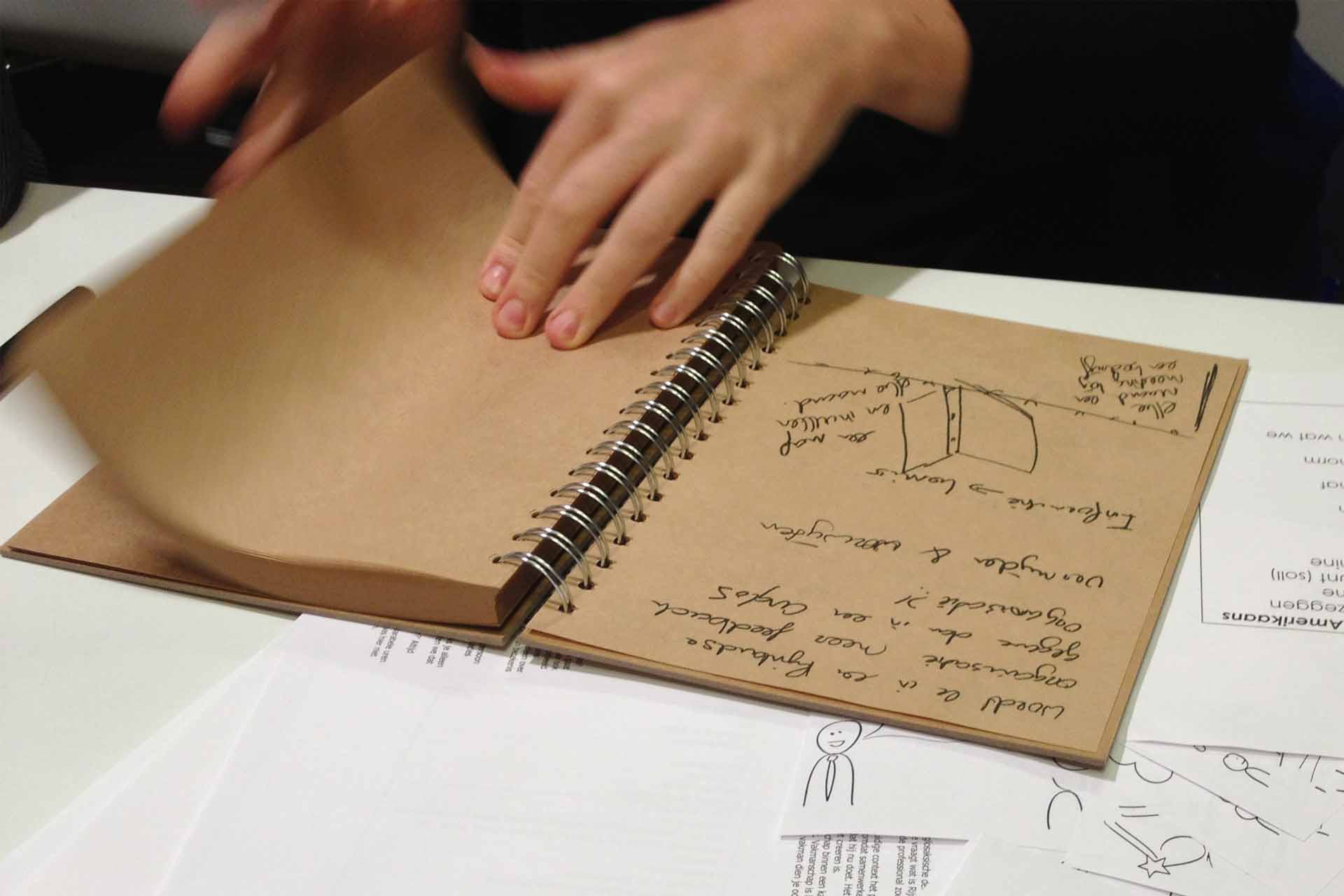CQ2: Creativity in The West anno 2020
 The West anno 2020: we all need to be creative. The World Economic Forum’s (WEF) research ‘The Future of Jobs’ (2016) stated that creativity would be the 3rd most important skills to have in 2020. Right after complex problem solving (number 1) and critical thinking (number 2) (WEF, 2015). So there you have it.
The West anno 2020: we all need to be creative. The World Economic Forum’s (WEF) research ‘The Future of Jobs’ (2016) stated that creativity would be the 3rd most important skills to have in 2020. Right after complex problem solving (number 1) and critical thinking (number 2) (WEF, 2015). So there you have it. We believe creativity is a valuable ability to have. Why do we think creativity is valuable? And why do we think it is an ability in the first place?
Chapter 1 of the Creativity Quartet 2020, focuses on our Western beliefs on creativity. This article, in particular, focuses on the more general issues, answering the questions above. In the subchapters I will discuss four specific beliefs we hold on creativity: (1) the belief in creative industries, (2) the belief that creativity is about idea generation, (3) the belief that creativity is about ‘outside the box thinking’, and finally (4) the notion that creativity is either something you hate or love.
Business rules the world and creativity rules business
We live in a world of motion and accelerating change. Status quo doesn’t exist anymore, dynamic quo would be a better word to describe Western World today. The faster pace started in the Enlightenment period, picked up pace in the Industrial Revolution, and is currently going exponentially faster in our Informational or Digital Revolution. Every new invention, in material and non-material form, the speeds up the creation of the next new invention.
Mobility, globalism and multiculturalism (whatever that exactly means) made everything relative. We denounce tradition and embrace change and newness. Take a walk around the supermarket and see how many packages say something like ‘New formula!’ We are all in search of innovative solutions.
As the law of offer & demand rules, scarcity drives demand and thus price. So if you can make something new and unique that is appreciated, you have struck gold (at least for a short period). Because we believe that creativity is the ability that makes us come up with new and unique ideas, businesses value creativity. And because businesses rule the world we, as a society, value creativity. I cannot make it more romantic than this. Fortunately, Weiner (2005) can: ‘In face of all the changes creativity seems to be one of the main values we can cling to: it is an expression of our talent and of our hope’ (Weiner, 2005: p98). Let’s keep up the positive spirit.
I like to think creativity is more than a resource for competitive advantage and I go with Weiner’s desperate but hopeful message that creativity is also about being a human BEING and not only a human RESOURCE. With that said, we tackled the first question: ‘why do we value creativity?’
To answer the second question I need a more elaborate argument. We first go back more than a hundred years and take a walk through the Industrial Revolution. I already smell the coal. This period changed our definition of culture, art and creativity. Then we skip WWI and go to WWII and the Cold War that ‘inspired’ us to redefine creativity again.
Culture or culture?
Before the Industrial Revolution, the word ‘culture’ was used to describe art. And art was created in ‘cultured societies’. That basically meant: ‘there is us and we think we understand ourselves so that is cultured, and there is the rest of the world we don’t understand so they are barbaric.’
In the Industrial Revolution, as an effort to understand the amount and speed of changes, anthropologists began to describe culture as the beliefs and customs of a group of people. That must sound like a logical description of culture to you. But for the people walking around in England in 1875 – to mention a not so random chosen year in the Industrial Revolution, you’ll see – this definition was not so logical. Most people probably never heard of the word culture anyway, being poor and all… Anyway, what was ‘culture’ in 1875 is considered ‘high-culture’ today, you know: ‘the Art-scene’.
Therewith, previously called barbaric societies gained appreciation. And what was made in exotic societies gained appreciation. That appreciation was not limited to art from other previously called barbaric societies. Also, crafts (even made by women!) gained appreciation. This development was supported by some popular artists that incorporated African styles into their work.
But, as crafts became art and as art could come from anywhere, the number of objects that were viewed as art exploded. That resulted in our contemporary believe that art can be found in any everyday objects. Now that we have that saddles, we still need a link from art to creativity. And we need to elaborate on the role of technology. We stay in 1875.
Beauty and creativity in technology
There was a time when ‘creativity’ did not exist. The word itself is also a child of the Industrial Revolution. Scientist and philosophers started to think that the process involved in making art was similar to the process they saw in the creation of all these new technologies. They needed a word to express that: and ‘creativity’ was born. The first mention of creativity in the English language was in 1875 (Weiner, 2005: p89).
Fun fact: ‘techne’ is an Ancient Greek word and means something like ‘gaining skill through practice and education’ Techne was later translated into Latin by the word ‘ars’. And we talk about art and technology as two different things…
The connection of the process of making art with the process of technological creation elevated the admiration for technological creation. Nowadays, we have the same admiration for new technologies as we have for art. Don’t we think the iPhone was a very creative innovation? Can a new car design not be creative? And as we moved from a production to a service society the concept of creativity moved with us. If cars and iPhones can be creative, why not intangible products as well: politics sports, teaching? Creativity can not only be found in objects but creativity can be found in all activities we do (Weiner, 2005).
With creativity that can be found in all and everyday activities, we are close to calling creativity a general human ability. We need WWII and the Cold War for the final pieces.
From creativity to problem-solving
Creativity was the process of bringing something into the new, whether it was art or technology. Let’s focus on technology, as technology has become a new religion. Why did we invent new technologies? To solve problems. So new technologies were created through creativity and the new technologies were created to solve problems. Hence, with our creativity we solve problems. In WWII and the Cold War this problem-solving view on creativity was emphasized.
Creativity enters the English language in 1875, but it is not after WWII that ‘creativity’ returns in most English dictionaries. WWII showcased the power of the creating (and destructing) potential and problem-solving skills of human beings. After WWII the USA immediately found itself in another problem situation: the Cold War. With their learnings from WWII, the USA started focussing on the problem-solving abilities of people and call this creativity. In the 1950’s American business, this view was made popular by Alex Osborn and later Sidney Parnes. In research, it was psychologist Joy Paul Guilford that laid the foundations for the view of creativity as a general human (problem-solving) ability.
Very short about Osborn and Guilford
Osborn is founding father of brainstorming and together with Sidney Parnes, he developed the method called Creative Problem Solving. Guilford was president of the American Psychologist Association and in 1950 his keynote speech was dedicated to creativity, urging his colleagues to take creativity seriously as a research topic, because creativity was a psychological ability in itself.
As the Americans spread its capitalistic ideas to the rest of Western civilization, they brought along their business and research ideas. Now, seventy-five years after Guilford opened the gate to creativity research, we still believe in Osborn’s and Guilford’s ideas on creativity. We assume you are now curious about what these ideas are. I won’t elaborate on them here. They will return at least in the articles belonging to card 4, 13, 14, 23, and 33, and maybe in other articles as well (see the complete list here). Let me say this: if you are part of a workshop and creativity is involved, 99% chance the ideas from Guilford and Osborn for the basis for the workshop.
Closing the circle
First, we explained how art went from being for exclusive objects to everyday objects, caused by a change in the meaning of the word culture. Second, we discussed how art is related to creativity, by explaining the similar creation processes of art and technology. Third, we explained how WWII and the Cold War change our perception of creativity as a way to create beauty in a way to solve problems. And fourth, we shortly showed how problem-solving became a general human ability. The question that remains is about the relation between art and problem-solving. What about it?
Even though creativity as problem-solving is more methodological in science and business, art can also be described as a problem-solving activity. Artists have problems like: How can I express my emotion on a white canvas? What colours do I need to use to create the atmosphere I want to create? In that sense, art has developed itself from being an imitation of nature (Plato) to an expression of emotion and imagination (Enlightenment, Romantic period), to a problem-solving activity.
And within one generation the problem-solving view on creativity became mainstream. Within one generation creativity moved from ‘being for artists’ towards one of the most important Western values (Weiner, 2005).
Now that we have a broader understanding of our problem-solving view on creativity, what else do we think is true on creativity? And why do we think that? The quartet of chapter one will exists out of the following topics:




Next week everything about creative industries, why they exist and what we can learn from that.
I wish you a pleasant continuation of your day.
Willemijn
The Creativity Quartet 2020 combines my knowledge on and experience with creativity. Just like any other person I have experience with creativity as long as I live, but more deliberate when I started studying Industrial Design Engineering (IDE@TUDelft) in 2001. I have over fifteen experience in facilitating and training creativity. My interest in creativity theory started in 2015. And I’m currently looking into doing promotional research on creating an overview of creativity theories.
I provide training in creativity & problem-solving to professionals, and I love to talk about creativity & problem solving on stage. To practice creativity, I also design serious/business games by request (Your Nine Dots) and I teach at IDE@TUDelft.
I do my best to source and summarize correctly. However, if you read anything incorrect or of the hook, please let me know! Ending with my favourite quote on creativity by Maya Angelou: “You can never use up creativity. The more you use, the more you have.”
References
- Weiner, R. P. (2005). Creativity & beyond: Cultures, values and change. Albany, NY: State University of New York Press.
Tags:
SUGGESTIONS FOR FURTHER READING

CQ13: Could Einstein paint like Picasso?
Could Einstein paint like Picasso? No. And Picasso was no brainiac like Einstein was. We give both men credit for their great creative contributions,

CQ8: Divine inspiration
Inspiration is a Gift from the Gods. Right. Let’s start our historical review with the Big 3: Socrates, Plato, and Aristotle. I will shortly mention t

CQ1: ‘Creativity is a lazy word’
Firstly, I wish you a happy, healthy and a h…[fill out your own h-word] 2020! Secondly, starting today I will post an article on creativity on my we

Title photo
Inspiration for inspiration
Would you like to receive the Creativity Quartet 2020 as inspiration? Think about how you can inspire us. For example, we have a coffee, you send us a book or article, link us to a person, point us to a website, etc. Leave your name and e-mail address and we’ll contact you for further information. We will not use your e-mail address to send you offers and won’t give away your information to other parties.



